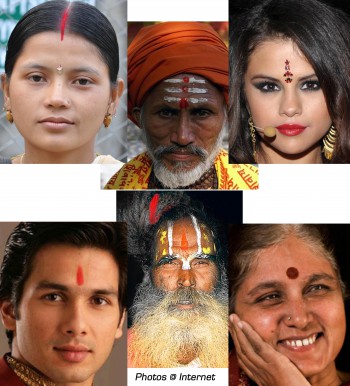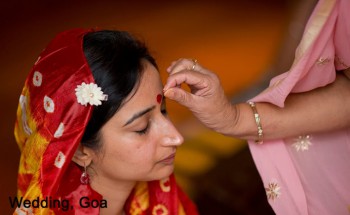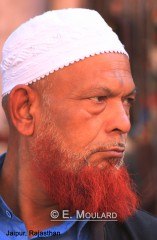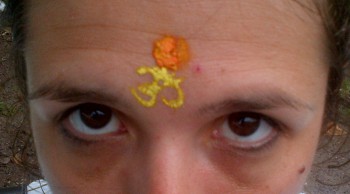10/30/2017
War of the zits (End)
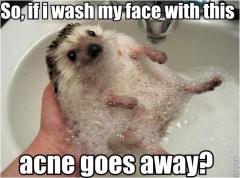 Regarding food, if my nanny thinks it’s butter and chocolate that are responsible for my acne (1), Dr. Google has a different opinion and suggests to stop white rice and milk (both sacrosanct elements of my nanny’s diet; you should have seen her face when I told her they were the culprits (she just thought I was making fun of her)) and pasta and bread (ayurveda adds sugar and coffee). I was just left with salad. And it was fortunate, since it was the leafy vegetable season!
Regarding food, if my nanny thinks it’s butter and chocolate that are responsible for my acne (1), Dr. Google has a different opinion and suggests to stop white rice and milk (both sacrosanct elements of my nanny’s diet; you should have seen her face when I told her they were the culprits (she just thought I was making fun of her)) and pasta and bread (ayurveda adds sugar and coffee). I was just left with salad. And it was fortunate, since it was the leafy vegetable season!
I refused my mom’s offer to use the radical treatment I took in my young years (Roacutane); I checked my thyroid (normal); I applied a mask (lemon juice and honey after washing the face with a hot towel) after scrubbing (with the above mentioned recipe) twice a week; I threw away the face solution of L’Occitane (I anyway never really understood how this foam could do anything against Indian dust) and ordered Marseille soap to my mother; I reduced the quantities of rice, stopped Nutella and coffee (replaced for a time by decaf) and started eating granola almost every morning; the weather changed with the summer taking over from the winter; I took a holiday in Europe. And after three months, I was (almost) saying goodbye – until next time at least! – to my (not so) juvenile acne and I still have no idea about what worked!
Except that obviously, a little while later, everybody had gotten back to their old habits, including my pimples.
Out of sheer despair, I decided to try ayurveda again. I had to drink a horrendous potion twice a day, and it didn’t even work the magic way it had the first time I had tried it, a few months after we moved to Gurgaon. It was a bit better but nothing to be happy about. Every other day I had to apply a smelly paste on my face why terrorized my son – he was yelling to everybody that I had become a gorilla! The treatment got ended by a formidable liver attack which required another ayurvedic medicine, much more drinkable this time. At that point of time, I couldn’t even be bothered about my face anymore…
For mother’s day, my husband got me… ayurvedic soap and oil… for acne. No useless gifts in our family!!
And then, slowly slowly, things started getting better, after seven months of ordeal. They definitely got better when I stayed a couple of weeks in France. I am not far from declaring that my skin is allergic to Gurgaon! Well, life goes on…
(1) In the same vein, I began to ‘check’ the popular theories of my nanny. And she has a lot of them!
Do not mix milk and fish. Beyond the fact that this association seems strange to me, I had never heard of this interdiction. Thinking of it, I actually have never heard about any food you could not combine with one another (except Baileys and Coke). Is this to say that this ‘science’ got lost somewhere (at least as far as I am concerned)? Or is it different in France? I found a recipe for cod with milk. And then I also found that Jewish ‘science’ says no to fish and milk. And finally that there is no risk of allergy or toxic reaction but rather digestive.
Do not mix meat and fish. “Because one lives in water and the other on the ground” according to my nanny. But she allows to mix fish and chicken because “chicken fly, it doesn’t really lives on the ground”. She had to justify fried rice with chicken and prawns! But then what about paella? Here again I find Jewish references on the issue, funny isn’t it?
Sources : http://www.masantenaturelle.com/chroniques/chroniques2/acne.php ; http://www.elephantjournal.com/2015/02/the-complete-anti-acne-diet/ ; http://easyayurveda.com/2014/08/04/ayurvedic-treatment-for-pimple-cause-herbs-home-remedies/ ; http://noskinproblems.com/lemon-juice-for-acne-and-acne-scars/ ; http://www.acne.org/lemon-juice-applied-topically-reviews-73/?&filters%5Breviews_per_page%5D=10&filters%5Bsort_by%5D=date+DESC&filters%5Brating%5D=1 ; http://www.torah-box.com/question/melange-viande-poisson-et-lait-poisson_357.html ; http://www.myjewishlearning.com/article/ask-the-expert-meat-and-fish/
08:00 Posted in My stories in India | Permalink | Comments (0) | Tags: india, zit, spot, skin, acne, pollution, weather, hone remedies, turmeric, lemon, ayurveda | ![]() Facebook | |
Facebook | |
10/23/2017
War of the zits (Beginning)
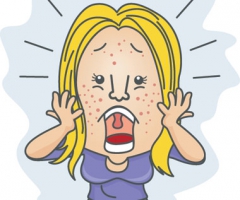 Mid-January, I started getting pimples on the face. I chose not to panic: one or two spots when you get your period is quite normal. Except that the bastards multiplied really fast and soon it (I) became quite ugly. Not knowing what to do, I continued washing my skin thoroughly and applying a bit of Kailash Jeevan (a magic Ayurvedic cream one can found in Mumbai and which heals any kind of injury; you can even eat it to cure indigestion!). But it just got worse. So when my nanny told me about her magical cure for the third time, I finally paid attention. According to her, I just need to use a home-made scrub: coarse sugar, salt and lemon juice. Not convinced and anyway enjoying a respite of the blooming, I let go, until new pustules appeared and she puts the ingredients in my hands, hereby stopping any kind of discussion. After all, I thought, maybe I should listen to the good old ‘folk wisdom’ (or knowledge? belief? common sense?) that has (almost) been lost in Western societies? So, I applied the scrub two to three days in a row, feeling my skin getting clearer. But a trip to Mumbai forced me to interrupt my ‘treatment’ for 3 days.
Mid-January, I started getting pimples on the face. I chose not to panic: one or two spots when you get your period is quite normal. Except that the bastards multiplied really fast and soon it (I) became quite ugly. Not knowing what to do, I continued washing my skin thoroughly and applying a bit of Kailash Jeevan (a magic Ayurvedic cream one can found in Mumbai and which heals any kind of injury; you can even eat it to cure indigestion!). But it just got worse. So when my nanny told me about her magical cure for the third time, I finally paid attention. According to her, I just need to use a home-made scrub: coarse sugar, salt and lemon juice. Not convinced and anyway enjoying a respite of the blooming, I let go, until new pustules appeared and she puts the ingredients in my hands, hereby stopping any kind of discussion. After all, I thought, maybe I should listen to the good old ‘folk wisdom’ (or knowledge? belief? common sense?) that has (almost) been lost in Western societies? So, I applied the scrub two to three days in a row, feeling my skin getting clearer. But a trip to Mumbai forced me to interrupt my ‘treatment’ for 3 days.
I enjoyed this short stay to go and say hello to my old nanny I had not seen for a year. She greeted me without any preamble:
- But Madam, what is this on your face? But it’s ugly, you must do something!
- Hello to you too! Yes, I know, I'm trying a scrub with sugar, salt, lemon.
- Lemon? Are you mad? No No, you must make a paste with turmeric and Chickpea flour and it will dry the infected parts very fast. Saffran is known for its antiseptic properties: when we get an injury we immediately put saffron, even you know it. But do it, huh, because this is really awful.
All that in front of her new employer, a girl I was meeting for the first time. Fortunately I’ve not been ashamed of anything in a very long time! Which comes handy when you are in your thirties and have the face of an adolescent with unleashed raging hormones.
I used my time in the taxi driving me to the airport to ‘check’ on the Internet what ‘science’ has to say about m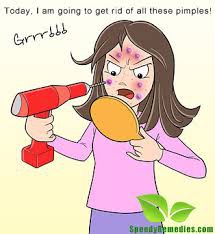 y nanny’s popular wisdom. Nothing about her scrub in particular but a clear message: ‘avoid scrubs’ because they attack the skin which is already traumatized enough (more precisely, when the skin is attacked it produces sebum as protection, and sebum is already produced in excess which is what clogs the pores, leading to infections). I could have checked earlier... What my nanny had also conveniently avoided to tell me it is that when this happened to her, the calci face, she scrubbed it with so much energy – what am I saying? With so much violence – that she is ripped half of her skin off. So of course the pimples left as well. Sometimes, I think she gets me concerned.
y nanny’s popular wisdom. Nothing about her scrub in particular but a clear message: ‘avoid scrubs’ because they attack the skin which is already traumatized enough (more precisely, when the skin is attacked it produces sebum as protection, and sebum is already produced in excess which is what clogs the pores, leading to infections). I could have checked earlier... What my nanny had also conveniently avoided to tell me it is that when this happened to her, the calci face, she scrubbed it with so much energy – what am I saying? With so much violence – that she is ripped half of her skin off. So of course the pimples left as well. Sometimes, I think she gets me concerned.
And then, at the airport, the army lady who checked me spurted a “but what do have you on the face? Is it chicken pox?? ”. But what is wrong with Indians that they always comment on your physical looks like that?
On that note, I tested the second recipe. ‘Improving it’ by adding lemon juice to bind the turmeric and the flour – upon the insistence of my nanny who really wants me to put lemon on my face (about this I read an interesting article with varied opinions on the use of lemon on the skin, which apparently, science rejects). What I can say for sure is that it had a great impact. On the bedsheets at least. When Baby Samourai grabbed the cup and spilled the powder all over: saffron is magic, you can hardly remove it. Other than that, I continued to apply the paste every night, for three days, until I forgot.
I had already tried an Ayurvedic medicine which had had terrific results, working as a blood purifier or something like that. But this doctor, just like all the dermatologists I’ve met before, treated the symptoms without trying to understand where the problem comes from. Food and digestion? Lack of sleep with baby Samurai waking up two or three times every night? Hormonal imbalance? Pollution? Weather? Dust? Stress? Anything else?
(To be continued)
08:00 Posted in My stories in India | Permalink | Comments (0) | Tags: india, zit, spot, skin, acne, pollution, weather, hone remedies, turmeric, lemon, ayurveda | ![]() Facebook | |
Facebook | |
10/14/2013
Why in India people have red marks on the forehead?
Or, if we dig deeper, Who, when, how, where?
We can distinguish different ‘marks’: the dot in the middle forehead, the line at the root of the hair and the lines and other designs on the forehead. These marks are often red, but not always. It’s not easy to understand the whole thing!
So who wears what? Does a red dot mean a woman is married?
In North India, the red dot on the forehead would be traditionally the prerogative of married women. But not in South India. Anyway it has become a fashion element, which varies in shape, color and material (the sticker – top right photo – has been giving tough competition to the traditional bindi – bottom right).
It seems however that the sindoor applied at the root of the hair (top left) is only applied by married women (a way of saying don’t touch! – like others do with a ring!).
Men can also wear the tilak, for religious or aesthetic reasons.
In fact anyone (Hindu or not, man or woman, Indian or not) will bear a red mark on the forehead after attending a puja (religious ceremony): whether it's a small prayer at home or in the temple, it always ends by a marking on the forehead...
So... why?
Firstly for aesthetic reasons: Indians find it beautiful! Tastes and colors are not to be discussed...
Secondly the dot on the forehead is a Hindu religious symbol since the tilak, placed on the sixth chakra (‘agna’), represents the third eye or the eye of the mind, associated with deities and the concepts of meditation and spiritual enlightenment. It was originally exclusively for ‘knowledge holders’: idols, priests, ascetics. (1) The Vishnu worshippers’ tilak is a U of white color (obtained from sandalwood) drawn around a red or black line (bottom middle photo). And for Shivaites it is formed by three horizontal lines made from ashes (top middle). (2)
But above all there is a 'scientific' explanation: the body– the forehead and the point 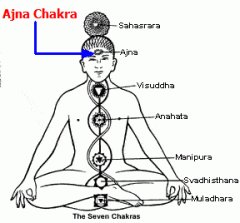 between the two eyes (seat of memory and thoughts) in particular – would produce energy in the form of electromagnetic waves. That’s how stress or anxiety creates heat and causes headaches. (1)
between the two eyes (seat of memory and thoughts) in particular – would produce energy in the form of electromagnetic waves. That’s how stress or anxiety creates heat and causes headaches. (1)
In Tantrism, during meditation, energy flows from the base to the head and leave the body by this point; hence the idea of "plugging the hole" to retain the energy inside. (3)
It is therefore to protect themselves and avoid energy losses that Hindus mark their forehead with a soothing and cooling powder paste.
Indeed, if the 'mark' varies in shape, colour, material and name ('tika', 'pottu', 'sindoor', 'tilak', 'tilakam', 'kumkum' and 'bindi', 'vermilion'), the traditional base (kumkum powder) is obtained by adding a few drop of lime to the yellow turmeric powder which then turns red (and add a little water to make it a paste). Some recipes contain saffron. And it turns out that both turmeric and saffron have medicinal properties as pain-killers! (4)
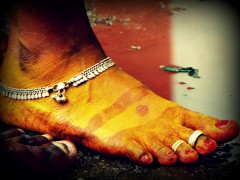 Turmeric is very present in the Indian culture. For example, in Andhra Pradesh, women used to apply it on (and under) the feet every day to protect them (because there were not too many shoes at the time (not that everyone wears shoes today either)). (5)
Turmeric is very present in the Indian culture. For example, in Andhra Pradesh, women used to apply it on (and under) the feet every day to protect them (because there were not too many shoes at the time (not that everyone wears shoes today either)). (5)
Indians may not have invented hot water* (not that they really need it anyways!) but their knowledge about medicinal plants is simply fascinating! Take henna. Not only is it cooling,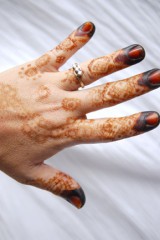 but also it is a coagulant for open wounds. Hence the tradition of Indian women to apply henna on their fingertips to protect themselves from the injuries inherent to manual chores. (6)
but also it is a coagulant for open wounds. Hence the tradition of Indian women to apply henna on their fingertips to protect themselves from the injuries inherent to manual chores. (6)
Here I owe an apology to my mother... After asking a thousand questions she came up with this one: “Tell me, why do these men have orange hair and beard?” I was a little bit upset with myself for not knowing the answer so I just told her whatever non-sense came to my mind: it is because they have used a bad quality dye which has faded!
In fact it seems that some men voluntary decide to have orange hair by dying it with henna. Apparently it could be because some Indians want to hide their gray hair but don’t have enough money to buy a good quality (black) dye. (7) The use of henna can also be linked to religion, as Islam would prohibit any dye except for henna. (8) When I asked my salesguy why do some people have orange hair he just told me that when people start to have gray hair they dye it, sometimes in black, sometimes in orange. No need to overthink it! You see Mum… ;)
* Sheer provocation?? Not only ! Apart from the zero, difficult to think of anything Indians actually invented… It doesn’t mean they are dumb though… They have stuff like the jugaad (in very short, “the gutsy art of overcoming harsh constraints by improvising an effective solution using limited resources”). Read more here.
(2) http://fr.wikipedia.org/wiki/Tilak
(3) http://hinduism.about.com/od/bindis/a/bindi.htm
(4) http://www.safrandugatinais.fr/en/vertus.htm; http://www.healthdiaries.com/eatthis/20-health-benefits-of-turmeric.html
(5) http://www.nandyala.org/mahanandi/?p=925
(6) http://www.ft.com/cms/s/0/d2933fb0-83de-11dc-a0a6-0000779fd2ac.html#ixzz2fW2qoFNh
(7) http://www.earthhenna.com/c158/c105/c98/The-Henna-Plant-c104.html
(8) http://ask.metafilter.com/88073/Why-would-a-Muslim-man-use-henna-to-dye-his-beard-orange
08:00 Posted in Why in India... | Permalink | Comments (0) | Tags: hair, hairs, beard, jugaad, innovation, orange, dye, henna, turmeric, saffron, spices, red dot, red mark, forehead, chakra, energy, meditation, third eye, tika, pottu, sindoor, tilak, tilakam, kumkum, bindi, agna, puja, kumkum powder, vermilion, orange hair | ![]() Facebook | |
Facebook | |















